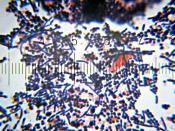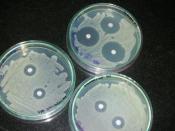Introduction
Bacteriology is the study of bacteria, especially as it pertains to medicine (Carter 323). Bacteriology is particularly interested in the effects of certain products, potential antibiotics, on bacteria. The purpose of this experiment was to test the effects of common foods, green tea, honey, and garlic, on bacteria, thus discovering if any of the fore stated products have antibiotic qualities. An antibiotic is any product that can destroy or inhibit the growth of other microorganisms (342). Antibiotics are used in a variety of products including soaps and lotions, as well as in medication to prevent the growth of such microorganisms.
It is relatively easy to quantify the effects of antibiotics on bacteria by using the disk diffusion test (345). The potential antibiotic is impregnated onto filter disk in the center of a developing culture of bacteria. Thus the antibiotic is allowed to diffuse onto the adjacent medium providing a gradient of the antibiotic.
After the culture is properly incubated, a bacterial lawn will appear in the plate. If the antibiotic agent is effective, then a zone of inhibition of bacterial growth will form around the disk (343). The zone will look like a blank space in bacterial growth. The size of the zone is dependent of three things: the diffusion rate of the antibiotic, the degree of sensitivity of the bacterium, and the growth rate of the microorganism (Garrity 97).
The experiment tested the effects of three potential antibiotics on two types of bacteria, E. Coli and Bacillus. These were selected based on the fact that these two types of bacteria stain into the two different categories. E. Coli is gram-negative appearing pink after stained, and Bacillus is gram-positive, appearing violet. Gram staining is used to classify bacteria based on the appearance or absence of a peptidoglyc layer (Purves...


